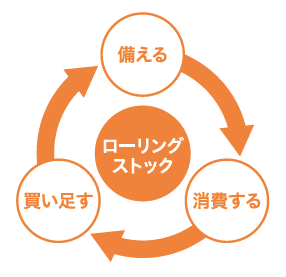Here's the text.
Stockpiling
Last Updated November 1, 2024
Do you have stockpiling or emergency listings?
Immediately after a disaster occurs, it becomes difficult to purchase food and daily necessities. Consider your family structure and make the necessary stockpiling.
Also, be sure to prepare an emergency exhibit where you can take it out immediately. Estimated amount of stock is at least 3 days.
~ Stockpile ~
Drinking water: The standard is 9l for 3 days per person. (Example) In the case of a family of 3 people x 9l = 27l
Food: Crackers that can be eaten without cooking, canned food (things that do not require can openers), etc.
※If you are allergic to food, stock up on what is right for you.
Toilet Pack: Set of "coagulant" and "processing bag" to be installed and used in toilets at home. It can be purchased at home improvement stores.
※5 times a day per person x 15 pieces for 3 days is a guide. (Example) In the case of a family of 3 people x 15 pieces = 45 pieces
-Emergency exhibit~
Flashlight
Lantern: Let's prepare a spare battery.
Mobile radio: Prepare something that can be heard both AM and FM, and prepare a lot of spare batteries.
Valuables: Cash, bank account, private seal, health insurance card
Other: Paper plates, paper cups, emergency medicine (bansoko), regular medicine, mobile phone charger, wet tissue, sanitary products, plastic bags, towels, gloves, food wraps
Such an emergency exhibit is also available in such a home
What should be prepared at home with infants
Milk, baby bottle, baby food, spoon,
Diapers, wipes, changing clothes,
Baby blankets, piggyback cords, infant toys
Items to be prepared at home with care recipients
Reserves for changing clothes, diapers, handbooks for persons with disabilities, assistive devices, etc.
What should be prepared at home with pregnant women
Spreading, cotton wool, gauze, mother and child handbook, newborn supplies
Learn from past earthquake experience-What was good at the time of the disaster-
In the past major earthquakes, water outages occurred, and many people were in trouble with domestic water (washing, bathing, washbasin), toilets, and water for eating and drinking. Therefore, it is said that not only water storage, but also plastic tanks, trolleys that carry water, and wet tissues that lift the body were particularly useful.
In addition, many people were having trouble eating and contacting families due to power outages and gas interruptions, and flashlights, portable radios, mobile phone chargers, batteries, and tabletop stoves were also useful.
In addition, for women, it is said that stockpiling sanitary products was also useful.
Consider the gender and age of yourself and your family and make the necessary stockpiling.
"Rolling stock" is recommended for stockpiling!

“Rolling Stock” refers to
They buy a little more food and daily necessities according to their family structure and lifestyle.
This is the concept of "circular stockpiling" in which new purchases are made while using the prepared items in order.
Let's incorporate "rolling stock" into our daily lives.
[Reference] "Tokyo Stockpile Navi" Let's check the stockpiling that suits you.
Tokyo Stockpile Navi-Let's check the stockpiling that suits you (outside site)
This site is published by the General Affairs Bureau Disaster Prevention Department of Tokyo.
For those who do not come to the point when they hear "stockpiling in preparation for disasters" or those who are interested but do not know what to stock up and how much to stock, we introduce the stockpiling Iroha and items that should be prepared .
Inquiries to this page
Regional Disaster Prevention Section, General Affairs Bureau Crisis Management Department
Telephone: 045-671-3456
Telephone: 045-671-3456
Fax: 045-641-1677
Email address: so-chiikibousai@city.yokohama.lg.jp
Page ID: 745-398-413







